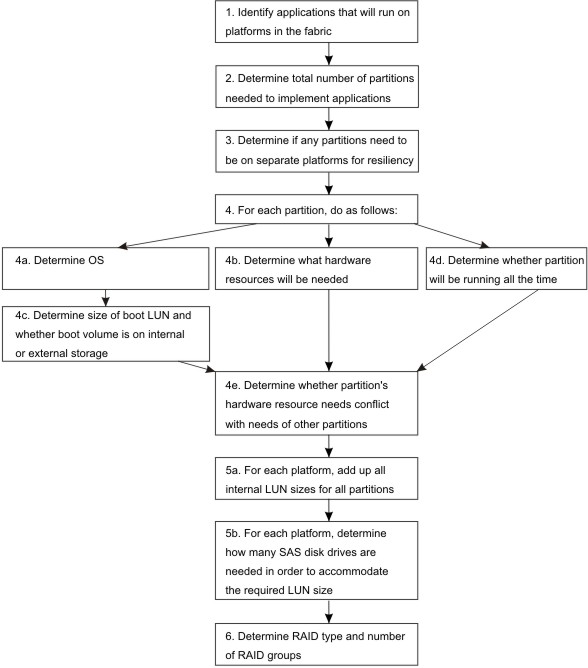The following information describes planning that you should do before your ClearPath Forward product arrives and even before you order it, to ensure that your fabric environment meets the needs of your applications.
Planning Prior to Ordering
Before ordering your ClearPath Forward fabric, plan your fabric environment as follows.
Identify the mission-critical enterprise applications or portions of applications that you will be running on Intel platforms in your ClearPath Forward fabric.
(Formally, an Intel platform is called an enterprise partition platform.)
Determine the total number of partitions needed to implement the applications or portions of applications.
(Each partition is one operating environment; that is, each partition hosts one operating system and its software stack.)
Determine if any two (or more) partitions need to be on separate Intel platforms (enterprise partition platforms) for resiliency purposes. That is, if you have two partitions that you do not want to be simultaneously unavailable, then for added resilience you should assign them to different Intel platforms.
For each partition, do as follows.
Determine the type of operating system that will run on the partition.
Windows Server 2008 R2 SP1 Enterprise Edition
Windows Server 2008 R2 SP1 Datacenter Edition
Windows Server 2012 Standard Edition
Windows Server 2012 Datacenter Edition
Windows Server 2012 R2 Standard Edition
Windows Server 2012 R2 Datacenter Edition
SUSE Linux Enterprise Server 11 SP3
SUSE Linux Enterprise Server (SLES) 11 SP4 (available as a customer-supplied OS only)
SUSE Linux Enterprise Server 12
SUSE Linux Enterprise Server (SLES) 12 SP1 (available as a customer-supplied OS only)
Red Hat Enterprise Linux 6.7 (available as a customer-supplied OS only)
Red Hat Enterprise Linux 7.1
Red Hat Enterprise Linux 7.2 (available as a customer-supplied OS only)
CentOS 6.7 (available as a customer-supplied OS only)
CentOS 7.2 (available as a customer-supplied OS only)
Note: For the latest list of supported operating systems for your release, refer to the ClearPath Forward Supported Operating Systems link that is available from the ClearPath Forward portion of the Unisys Product Support site.
Determine what hardware resources—instruction processor cores, memory, network interface controller (NIC) ports, host bus adapter (HBA) ports, and Mellanox host channel adapter (HCA) logical ports—will be needed by the partition.
Determine the size of the LUN needed by the partition (see LUN Planning and whether the partition boot volume will be on internal or external storage.
Note: You should do this for all enabled partitions that are available concurrently, regardless of whether those partitions are running or stopped. But you should also do it for any disabled partitions that will be dormant, because disabled partitions also occupy a LUN.
Determine whether the partition will be running all of the time or only part of the time (that is, always enabled, or sometimes disabled in favor of another partition executing in the same space).
Do both of the following:
Determine whether the partition’s hardware resource needs—instruction processor cores, memory, NICs, HBAs, and HCAs—will conflict with the needs of other partitions.
Determine whether the partition’s hardware resource needs will conflict with the needs of other partitions if you must change the resize of the partition.
See Visual Aid for Understanding Chassis and Cores They Can Include to understand how the hardware resource needs of one partition may conflict with another.
If you do find conflicts, consider whether the partitions in conflict have to run at the same time. If a partition will only run part of the time, perhaps another partition that uses the same hardware resources can run at a different time, so that there is no conflict for resources.
For each platform:
Add up all of the internal LUN storage sizes for all of the platform’s partitions. (Remember to include partitions that will not be simultaneously enabled.) This gives you a total required LUN storage size for the platform.
Determine how many SAS disk drives the platform needs in order to accommodate the total required LUN storage size for the platform.
See Virtual Disks (LUNs) for Internal Storage for detailed information on LUN planning, including how much LUN storage space is available when different numbers of SAS disks are ordered.
Note the following:
The total storage size of all of the partition LUNs on a platform affects the number of possible partitions that the platform can support. Having too many partitions with large LUN storage sizes might exceed the capacity of the number of SAS disks that you have purchased for a given platform.
Regardless of the total LUN size, there is a maximum of 11 customer LUNs in the base configuration EPP RAID group and 16 customer LUNs in additional RAID groups.
Determine what RAID type (level) you want, for example RAID 5; and how many RAID groups you want. (See RAID Configurations and RAID Groups.)
Flow Chart
The following figure summarizes the preceding information in flow chart form.

At Ordering Time
Based on the preceding planning, you will be able to provide the required information when you order your ClearPath Forward fabric or set it up initially:
How many Intel platforms (partitionable enterprise partition platforms) do you need?
For each platform, what operating systems will be run?
For each platform, how many internal SAS disk drives do you need, and of what type?
For each platform, what type (level) of RAID do you want for data protection, and how many RAID groups?